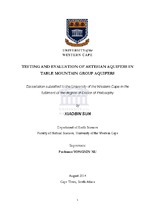| dc.description.abstract | The Table Mountain Group (TMG) Aquifer is a huge aquifer system which may provide large bulk water supplies for local municipalities and irrigation water for agriculture in the Western Cape and Eastern Cape Provinces in South Africa. In many locations, water pressure in an aquifer may force groundwater out of ground surface so that the borehole drilled into the aquifer would produce overflow without a pump. Appropriate testing and evaluation of such artesian aquifers is very critical for sound evaluation and sustainable utilization of groundwater resources in the TMG area. However, study on this aspect of hydrogeology in TMG is limited. Although the flow and storage of TMG aquifer was conceptualised in previous studies, no specific study on artesian aquifer in TMG was made available. There are dozens of flowing artesian boreholes in TMG in which the pressure heads in the boreholes are above ground surface locally. A common approach to estimate hydraulic properties of the aquifers underneath is to make use of free-flowing and recovery tests conducted on a flowing artesian borehole. However, such testing approach was seldom carried out in TMG due to lack of an appropriate device readily available for data collection. A special hydraulic test device was developed for data collection in this context. The test device was successfully tested at a flowing artesian borehole in TMG. The device can not only be used to measure simultaneous flow rate and pressure head at the test borehole, but also be portable and flexible for capturing the data during aquifer tests in similar conditions like artesian holes in Karoo, dolomite or other sites in which pressure head is above ground surface. The straight-line method proposed by Jacob-Lohman is often adopted for data interpretation. However, the approach may not be able to analyse the test data from flowing artesian holes in TMG. The reason is that the TMG aquifers are often bounded by impermeable faults or folds at local or intermediate scale, which implies that some assumptions of infinite aquifer required for the straight-line method cannot be fulfilled. Boundary conditions based on the Jacob-Lohman method need to be considered during the simulation. In addition, the diagnostic plot analysis method using reciprocal rate derivative is adapted to cross-check the results from the straight-line method. The approach could help identify the flow regimes and discern the boundary conditions, of which results further provide useful information to conceptualize the aquifer and facilitate an appropriate analytical method to evaluate the aquifer properties. Two case studies in TMG were selected to evaluate the hydraulic properties of artesian aquifers using the above methods. The transmissivities of the artesian aquifer in TMG range from 0.6 to 46.7 m2/d based on calculations with recovery test data. Storativities range from 10-4 to 10-3 derived from free-flowing test data analysis. For the aquifer at each specific site, the transmissivity value of the artesian aquifer in Rawsonville is estimated to be 7.5–23 m2/d, with storativity value ranging from 2.0×10-4 to 5.5×10-4. The transmissivity value of the artesian aquifer in Oudtshoorn is approximately 37 m2/d, with S value of 1.16×10-3. The simulation results by straight-line and diagnostic plot analysis methods, not only imply the existence of negative skin zone in the vicinity of the test boreholes, but also highlight the fact that the TMG aquifers are often bounded by impermeable faults or folds at local or intermediate scale. With the storativity values of artesian aquifers derived from data interpretation, total groundwater storage capacity of aquifers at two case studies was calculated. The figures will provide valuable information for decision-makers to plan and develop sustainable groundwater utilization of artesian aquifers in local or intermediate scales. With the hydraulic test device readily available for data collection, more aquifer tests can be carried out in other overflow artesian boreholes in TMG. It becomes feasible to determine the hydraulic properties of artesian aquifers for the entire TMG. Thereof quantification of groundwater resources of artesian aquifers in TMG at a mega-scale becomes achievable. This would also contribute towards global research initiative for quantification of groundwater resources at a mega-scale. | en_US |

